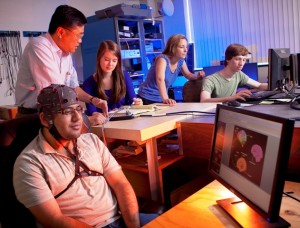A group of students and faculty is working to give some control back to those who have lost the ability to move.
In research that brings together neuroscience and electrical and computer engineering, the team is working on technology that will allow users to control computer applications using their brainwaves.

Rameel Sethi ’15, l-r, Yih-Choung Yu, associate professor of electrical and computer engineering, Maura Schlussel ’15, Lisa Gabel, associate professor of psychology, and Tom Fuller ’16 work in the brain-computer interface lab.
The interdisciplinary project, which has been ongoing since summer 2011, began with the team designing a memory game that can be played through a brain-computer interface (BCI). Under the guidance of Yih-Choung Yu, associate professor of electrical and computer engineering, and Lisa Gabel, associate professor of psychology and chair of neuroscience, three BCI-related honors theses were successfully finished to study:
- the correlation of visual attention to BCI performance
- the design of a BCI for robot navigation
- the feasibility of improving performance on mu rhythm-based (a synchronized pattern of neuron activity resulting in waves that repeat 8-13 times per second) BCI.
Yu and Gabel, along with Luis Schettino, assistant professor of psychology, received a National Science Foundation grant to purchase additional equipment, including a wireless headset device.
This summer’s research has three main parts: Neuroscience major Maura Schlussel ’15 continues research on subject testing to strengthen the statistical results from the previous project, computer science and electrical and computer engineering double major Thomas Fuller ’16 is designing a software program to convert the video data collected in BCI experiments to facilitate further analysis, and electrical and computer engineering major Rameel Sethi ’15 is creating software modules for future BCI design with a wireless headset.
“I use an EEG to detect variations in cortical rhythms (mu rhythms, specifically) in the sensorimotor cortex,” says Schlussel, who hopes to attend medical school after she graduates. “My research is involved in examining how to improve participants’ abilities in controlling their mu rhythms.”
Fuller is also working to detect patterns for certain thoughts and mapping those thoughts through different commands in order to control a remote-control helicopter.
“Going into this, I knew very little about the whole thing aside from electrodes being hooked to the brain,” he says. “Now I know a bit about which parts of the brain light up for certain activities in addition to the difficulties surrounding collecting these very small signals and making a clean response from something so complicated and so hard to measure.”
As mobile devices are improving, BCI designs are also moving towards wireless. Yu and Gabel have started exploring the idea of using a wireless EEG headset for future BCI projects. This would allow the BCI users to have more freedom while using the BCI.
BCI technology has the potential to improve the lives of those suffering from neurological conditions such as amyotrophic lateral sclerosis (ALS), stroke, and paralysis.
